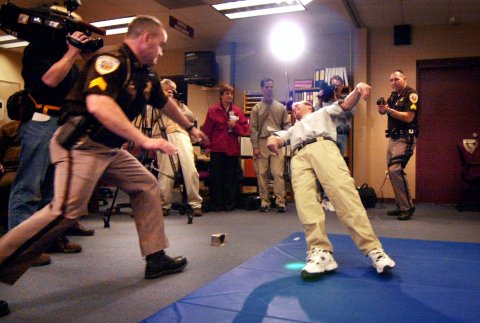For its first 15 minutes, Tom Swift and His Electric Rifle, Nick Berardini's documentary about Taser International, is a classic all-American success tale: It recounts the origin story of Rick and Tom Smith, ambitious brothers who adapted ineffective stun-gun technology to revolutionize policing while earning millions of dollars.
Then the tone changes. Berardini shows the Smiths talking about the dangers of the Taser, the electronic control weapon Amnesty International says contributed to 540 deaths between 2001 and 2013. "My film speaks to our inclination to find an easy solution to a complicated problem," says Berardini, whose documentary had its world premiere in April at the Tribeca Film Festival and is currently seeking distribution. "But militarizing the police desensitized them and changed the way they handle use-of-force incidents."
He stumbled upon the story while working as a student reporter at the University of Missouri in 2008, covering the death of 23-year-old Stanley Harlan, who was pulled over across the street from his home in Moberly, Missouri, for going 38 mph in a 35 mph zone. Harlan was inexplicably Tased by the police for 31 seconds and died, in front of his mother. Berardini initially planned a documentary on how this incident divided the town, but after a special prosecutor dropped the charges after concluding that the police training did not indicate repeated Tasings could be lethal, he decided to focus on those who had provided the training: the Smith brothers and Taser International.
"They were saying no one could ever die from a Taser," Berardini says. "It certainly has killed people.… So I set out to make a movie about their journey and their successes and the collateral damage.… I want police officers to see this so they are aware of the consequences of using a Taser."
Taser Vice President Steve Tuttle has not seen the movie, but argues that the weapon is a vast improvement over pain-compliance tools used by the police, like choke-holds, batons and pepper spray—the discomfort from which can last an hour, while a Taser shot lasts five to eight seconds. "It is also safer for the officer than tackling someone to the ground, and the police have saved money in worker's compensation," Tuttle says. "We never said the Taser is risk-free. Nick is painting us to be uncaring souls, but we are on a noble mission."
Justin Mazzola, a researcher at Amnesty International, says approximately 40 people die each year from incidents involving Taser abuse—shots lasting longer than the recommended time—and argues the weapon needs more rigorous testing.
The movie is also about what Eugene O'Donnell, a former New York police officer and assistant district attorney who is now a professor at the John Jay College of Criminal Justice in New York, calls "the big industrial-police complex," where weapons are sold to departments before guidelines and testing have been done by them.
Tom Swift reveals this through disturbing footage, like a 2007 incident at the Vancouver International Airport in British Columbia in which a disoriented Polish man was surrounded by four policemen who make no effort to find a nonviolent solution, instead stunning him repeatedly after he is on the ground with officers on top of him. He was pronounced dead at the scene.
The film juxtaposes such scenes with one in which Rick Smith says, "In every single case, these people would have died anyway." Or another in which Tom Smith declares the company never said the weapon was risk-free, only to be contradicted by its promotional materials. The movie also presents evidence that the company was warned about risks by its scientists in 2006. In 2009, Taser finally changed its policy and recommended officers not fire at the chest, yet the film shows a nationwide call with its police department clients in which Rick Smith undercuts that by saying, "Are chest hits with a Taser dangerous? The answer to that is definitively no."

Tuttle refutes the Amnesty International death toll and other concerns, citing numerous studies. The Department of Justice study he cites actually warns that Tasers should not be used for longer than 15 seconds and that the electric charges appear to be safe only in "healthy, non-stressed, non-intoxicated persons," and that "it is critical that law enforcement officers minimize or avoid multiple or prolonged" use of the weapon.
Berardini says that by bombarding the media with reports, Tuttle is aping the tactics of Big Tobacco and climate change deniers—creating a "debate, and so people assume there's truth on both sides."
Berardini also points to the recent shooting in Oklahoma where Robert Bates, a reserve deputy, shot a man being held on the ground by other deputies. Bates said he meant to pull his Taser, not his gun, but Berardini questions even that decision. "It speaks to how quickly officers are rushing to take risk away. That was not proportional force," he says, adding that being pinned to the ground heights the dangers of Taser use.
With more than 95 percent of the nation's police forces owning Tasers, the questions the movie raises are worthwhile. Giving police another weapon seems to have contributed to a Tase-first mentality, even if the victim has done nothing more than question the police officer or provide other "passive non-compliance," as happened in Miami with a 12-year-old girl who was playing hooky and fled. Or, recently in Texas, to a 76-year-old man stopped for an expired inspection sticker.
Chuck Wexler, executive director of the Police Executive Research Forum, a national organization of top police officials, says that too many officers think: I have this weapon, so I'll use this weapon instead of calling for backup or finding ways to de-escalate a situation verbally. "Many officers have a sense that the Taser can be used in all situations, and [that they] are harmless," he says. "But they are not. People are dying from being Tased too long."
While the film focuses mostly on Taser International, it's clear police departments and local governments bear responsibility for not creating their own strict policies and training. O'Donnell argues that governments and police departments abdicated their responsibility by allowing Taser to introduce a weapon and provide all the training early on, instead of running independent reviews and training. "Taser International is not elected and is not accountable," he says. "Officials have to step up and say, 'We own this.' Overreliance on Tasers is an issue that goes to the core of democratic policing."
Tuttle defends the company's training program, but agrees that the weapon is not always used properly. "We did not put this out there to be used willy-nilly," he says. "We cannot teach common sense, but we can teach smart use. If they use Tasers in cases of passive-resistance, the system will break down and they risk getting sued. When they don't do the training properly, I am shocked they're not sued more often."
Houston Executive Assistant Chief of Police Michael Dirden, who heads his department's Taser oversight committee, says the city's Taser use has evolved since 2004. The initial policies were not clear about what justified its use, nor did the company give guidance about the potential dangers of using the weapon on the drunk, the elderly or the mentally ill. Early on, white officers were far quicker to Tase than black officers, failing to recognize that "African-American folks have a tendency to talk loud or argue, and that is not a prelude to a fight," says Dirden, who is African-American. When the department created its own education system about cultural differences, and training in de-escalation techniques and conflict resolutions, he says, the number of Taser incidents went down.
Many departments fail to make those adjustments. A 2011 study by the New York Civil Liberties Union showed that in New York state, 60 percent of Taser uses did not meet criteria set forth by outside experts; in 75 percent, there was no verbal warning; in 40 percent, the victim was at-risk (for being mentally ill, intoxicated, etc.); 27 percent were Tased in the chest; and more than one-third endured multiple or prolonged Taser shots. "Tasers have become a tool of escalation, rather than a substitute for de-escalation techniques that police experts support," says attorney Corey Stoughton, one of the study's authors.
She points to a Syracuse, New York, case from 2012, when a high school student refused to leave school without taking the final exam that would allow him to graduate. A police officer arrived with his Taser drawn and ultimately used it four times on the student, who never physically resisted.
Stoughton says that, unfortunately, the NYCLU report had little impact on local police departments; a lawsuit they helped bring against the Syracuse police department, however, led to drastic revisions in its Taser policy.
Taser International continues hyping its product with a running tally of lives saved and serious injuries averted, but the film casts serious doubts on that. In British Columbia, after the Vancouver airport incident, the government placed major restrictions on Taser use; despite an 87 percent decline in usage, there was no rise in suspect or officer injuries. Berardini also interviews Jere Green, police commissioner in Warren, Michigan, who completely ended his department's use of Tasers and found absolutely no change.
"Taser is saying, 'If you take this away, there will be chaos,'" Berardini says. "I wanted to at least present an alternative."
Correction: This article originally incorrectly identified attorney Corey Stoughton as male.





















